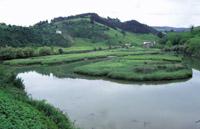The recovery of destroyed wetlands is not easy
2001/06/27 Roa Zubia, Guillermo - Elhuyar Zientzia
The destruction of 80% of existing wetlands in the area over the past two centuries has caused the Gulf of Mexico to be heavily contaminated. Wetlands play a very important role, constituting a space between the river and agricultural lands, both physically and ecologically. Among other things, they reduce the number of pollutants.

The problems of the Gulf of Mexico come from the waters of the Mississippi River. It is of great flow and leaves to the sea after traveling many states and big cities. The water flow rate is variable throughout the year and reaches its maximum in summer. In the water flow sludge, heavy metals and many chemical compounds, so in the gulf there are more and more pollutants. One of these pollutants is nitrogen (nitrogen compounds). Nitrogen has a great influence, especially on the metabolism of algae. The proposal of scientists is to recover the chemical and biological balance through wetlands.
In the United States there has been a new trend in recent years: the State authorizes the destruction of a wetland if the destroyer creates another nearby. Thus, over the past seven years, 42,000 acre wetlands have been converted to replace the 24,000 acre reduction.
However, the ecologists of the University of Wisconsin have explained the problems that this activity has, since artificial wetlands do not act like natural ones. Artificial lakes are built in places that would not be created by themselves and, in addition, no follow-up is performed to take control. According to ecologists, before destroying a natural wetland, data should be collected for at least five years.
Explanations and reports have been published. Now is George Bush's turn to address the issue and seek solutions.

Gai honi buruzko eduki gehiago
Elhuyarrek garatutako teknologia






